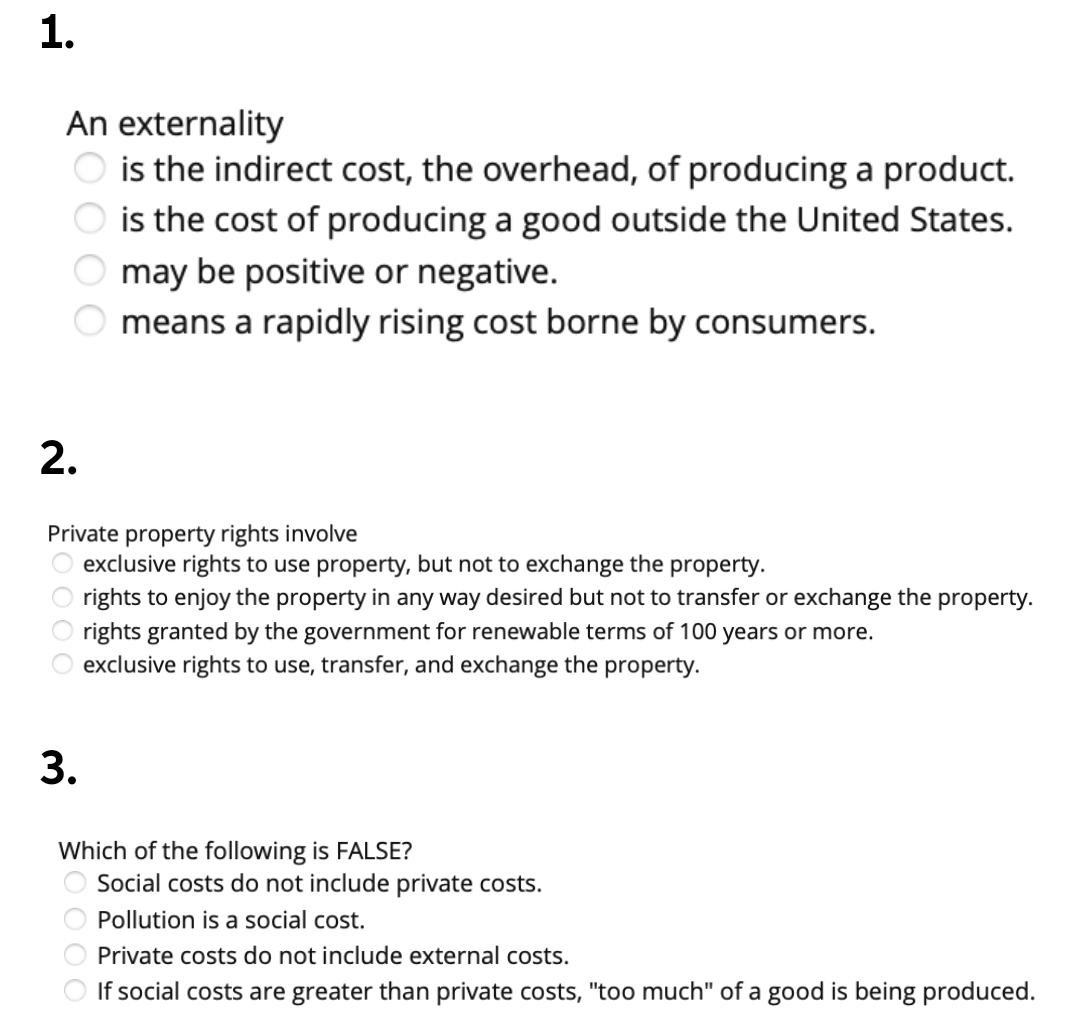An externality is the indirect cost, the overhead, of producing a product. is the cost of producing a good outside the United States. may be positive or negative. means a rapidly rising cost borne by consumers. 2. Private property rights involve exclusive rights to use property, but not to exchange the property. rights to enjoy the property in any way desired but not to transfer or exchange the property. rights granted by the government for renewable terms of 100 years or more. exclusive rights to use, transfer, and exchange the property. 3. Which of the following is FALSE? Social costs do not include private costs. Pollution is a social cost. Private costs do not include external costs. If social costs are greater than private costs, "too much" of a good is being produced. EO O O O
An externality is the indirect cost, the overhead, of producing a product. is the cost of producing a good outside the United States. may be positive or negative. means a rapidly rising cost borne by consumers. 2. Private property rights involve exclusive rights to use property, but not to exchange the property. rights to enjoy the property in any way desired but not to transfer or exchange the property. rights granted by the government for renewable terms of 100 years or more. exclusive rights to use, transfer, and exchange the property. 3. Which of the following is FALSE? Social costs do not include private costs. Pollution is a social cost. Private costs do not include external costs. If social costs are greater than private costs, "too much" of a good is being produced. EO O O O
Principles of Economics 2e
2nd Edition
ISBN:9781947172364
Author:Steven A. Greenlaw; David Shapiro
Publisher:Steven A. Greenlaw; David Shapiro
Chapter12: Environmental Protection And Negative Externalities
Section: Chapter Questions
Problem 5SCQ: Consider two approaches to reducing emissions of CO2 into the environment from manufacturing...
Related questions
Question
100%
Please answer all three questions.thank you

Transcribed Image Text:An externality
is the indirect cost, the overhead, of producing a product.
is the cost of producing a good outside the United States.
O may be positive or negative.
means a rapidly rising cost borne by consumers.
2.
Private property rights involve
exclusive rights to use property, but not to exchange the property.
O rights to enjoy the property in any way desired but not to transfer or exchange the property.
O rights granted by the government for renewable terms of 100 years or more.
exclusive rights to use, transfer, and exchange the property.
use
3.
Which of the following is FALSE?
Social costs do not include private costs.
Pollution is a social cost.
Private costs do not include external costs.
If social costs are greater than private costs, "too much" of a good is being produced.
O O O O
1.
Expert Solution
This question has been solved!
Explore an expertly crafted, step-by-step solution for a thorough understanding of key concepts.
Step by step
Solved in 2 steps

Knowledge Booster
Learn more about
Need a deep-dive on the concept behind this application? Look no further. Learn more about this topic, economics and related others by exploring similar questions and additional content below.Recommended textbooks for you

Principles of Economics 2e
Economics
ISBN:
9781947172364
Author:
Steven A. Greenlaw; David Shapiro
Publisher:
OpenStax

Principles of Microeconomics
Economics
ISBN:
9781305156050
Author:
N. Gregory Mankiw
Publisher:
Cengage Learning


Principles of Economics 2e
Economics
ISBN:
9781947172364
Author:
Steven A. Greenlaw; David Shapiro
Publisher:
OpenStax

Principles of Microeconomics
Economics
ISBN:
9781305156050
Author:
N. Gregory Mankiw
Publisher:
Cengage Learning



Essentials of Economics (MindTap Course List)
Economics
ISBN:
9781337091992
Author:
N. Gregory Mankiw
Publisher:
Cengage Learning

Principles of Economics (MindTap Course List)
Economics
ISBN:
9781305585126
Author:
N. Gregory Mankiw
Publisher:
Cengage Learning